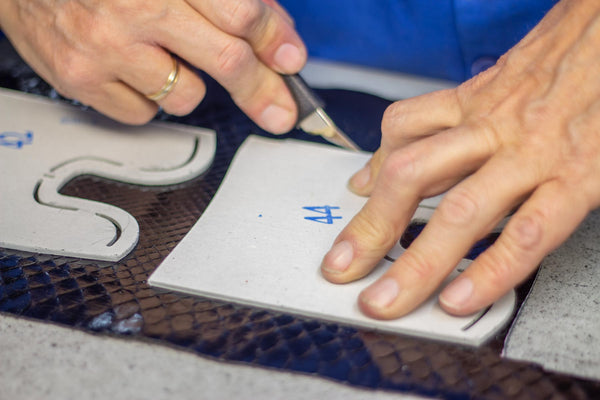Ihr Warenkorb ist leer
Wir beziehen exotische Häute von einem Verarbeiter, der gesunde Tierhaltung und humane Tierbehandlungs-/Schlachtmethoden anwendet, egal ob gezüchtet, domestiziert oder wild (gemanagt). Außerdem müssen Lederlieferanten Gerbprozesse anhand des LWG-Protokolls überprüfen, um die Einhaltung der besten Umweltpraktiken sicherzustellen (https://leatherworkinggroup.com).

Die Haut des „ Alligator mississippiensis“ ist ein sehr attraktives und modisches Leder. Das Leder ist stark, geschmeidig, haltbar und sehr teuer . Eine Knochenschicht in der Haut dient als Schutzschild, während eine Delle auf jeder Schuppe für ein sehr exotisches Aussehen sorgt.
Amerikanisches Alligatorleder stammt aus dem Südosten der USA und wird häufig von auf Farmen gezüchteten Alligatoren sowie von Wildtieren gewonnen. Es ist ein klassisches, haltbares und vielseitiges Leder. Die Haut des amerikanischen Alligators ist weicher und biegsamer. Das liegt daran, dass die Haut dieses Reptils weniger knochig ist als die Haut von Krokodilen. Diese Weichheit macht die Haut des Alligators leichter zu verarbeiten als die Haut anderer Reptilien und erleichtert das Schneiden, Nähen und Falten.

Straußenleder ist eines der feinsten und haltbarsten Leder. Es ist ein luxuriöses Leder, das für seine Weichheit, Flexibilität und Haltbarkeit bekannt ist . Trotz seiner Weichheit ist Straußenleder in seiner taktilen Stärke unübertroffen. Es ist tatsächlich eines der stärksten verfügbaren Leder. Natürlich vorkommende Öle im Leder tragen zu seiner Haltbarkeit bei und verhindern Risse, selbst bei extremen Temperaturen und Sonneneinstrahlung.
Das Hauptunterscheidungsmerkmal von Straußenleder sind die Federkiel- oder Federfachmarkierungen . Der „Vollkiel“-Bereich des Leders ist die begehrteste und daher teuerste Art von Straußenleder. Das Federmuster ist das Ergebnis großer Follikel, die jeweils eine Feder enthielten.

Schlangenhäute sind aufgrund ihrer einzigartigen Maserung, Schuppen und Farbmuster für Schuhe sehr begehrt . Schlangen werden auf zwei Arten gehäutet: Entweder werden die Bauchschuppen abgeschnitten, sodass die kleinen Schuppen in der Mitte verbleiben (Python mit „Bauch“- oder „Vorder“-Schnitt), oder man schneidet den Rücken ab, sodass die breiten Bauchschuppen in der Mitte verbleiben (Python mit „Rücken“-Schnitt). Wir verwenden den Python mit „Vorder“-Schnitt.
Die Schuppen dienten der Schlange als Schutz vor den Elementen und sind im Wesentlichen wie eine schwielige, abgestorbene Haut. Die Größe der Schuppen variiert je nach Hauteinschnitt. Die Schuppen haben eine „Lippe“, die zum Schwanz hin offen ist und der Schlange beim Kriechen hilft. Diese Lippe ist Ihre Garantie dafür, dass die Schlange echt ist.

Bitte beachten Sie, dass jede einzelne Haut einzigartig und echt ist. Bilder und 3D-Texturen dienen nur zur Veranschaulichung. Unsere Handwerker bemalen und schneiden jedes Schuhstück nach Ihren Wünschen von Hand. Außerdem arrangieren unsere Handwerker die Schnittmuster auf dem Leder auf Grundlage ihrer eigenen Erfahrung und ihres handwerklichen Könnens . Bitte haben Sie Verständnis dafür, dass es aufgrund des oben Gesagten zwischen zwei verschiedenen Schnitten zu Unterschieden in Schuppenmuster, Größe und Farbton kommen kann .